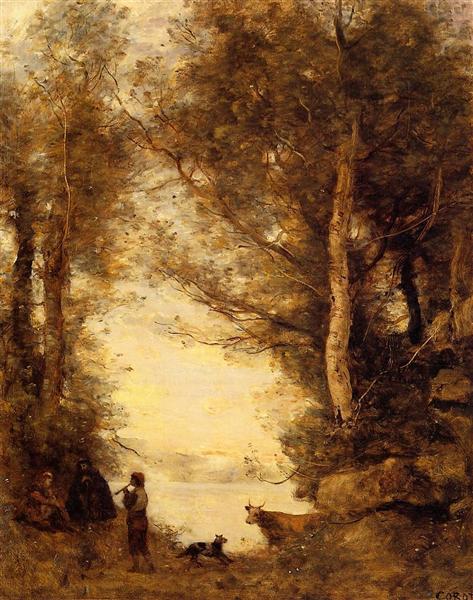Beskrivning
Arbetet "The Flutist of Lake Albano", målad 1872 av Camille Corot, registrerar sig i den rika traditionen i det romantiska landskapet under 1800 -talet och sammanslagning av den lugna naturen i naturen med element i den mänskliga figuren i en poetisk dialog. Corot, en framträdande representant för Barbizon -skolan, är känd för sin behärskning av att fånga ljus och atmosfär, och denna målning är ett vittnesbörd om hans känslighet för det italienska landskapet, som djupt inspirerade honom under hans resor.
Visuellt är sammansättningen effektivt strukturerad i ett övervägande horisontellt plan som framkallar landskapets enorma. I förgrunden blir en ensam flöjtist huvudpersonen i scenen; Hans figur är ordnad på sidan, gest med sitt instrument i en handling av musikalisk intimitet. Hans närvaro, även om den är subtil, känner sig integrerad i miljön, vilket tyder på en koppling mellan människan och naturen. Denna flöjtist, klädd i informella kläder, tittar mot ett landskap som utvecklas bakom det, vilket genererar en känsla av djup och ett visuellt språk av melodi och lugn.
Sjön, som ligger mitt i mjuka och trädbevuxna bergen, återspeglar en mjuk och harmonisk kromatisk palett, främst jordens gröna och blå nyanser av vattenytan. Corot använder "alla kusin" -tekniken i applicering av färg, som ger en livlig struktur genom de lösa och flytande penseldragen som fångar ljuset i vattnet och i den omgivande vegetationen. Denna strategi avgränsar inte bara rymden, utan skapar också en atmosfär av lugn och kontemplation, där tittaren nästan kan lyssna på melodin som härstammar från flöjtisten.
I bakgrunden är närvaron av träd väsentlig för komposition, eftersom de ramar in scenen, och spelet med ljus och skuggor mellan dem bidrar till känslan av tre dimensionalitet. Himmelens toner kontrasterar försiktigt med vegetation, med moln som antyder en tydlig dag men full av nyanser, vilket bidrar till känslan av en perfekt och kvarhållen tid i tid.
Användningen av den mänskliga figuren i Corots målning har ofta tolkat som en sökning efter kopplingen mellan individen och den naturliga miljön. Här är Flutist inte bara en ensam karaktär, utan också en symbol för mänsklig kreativitet nedsänkt i den naturliga världen. Valet av en musiker som en central figur kan också antyda en reflektion över konst som en form av universell kommunikation, resonera med den romantiska idén om naturen och människan i en unik kram.
Inom ramen för arbetet, "Flutisten i Lake Almean ett scenario för individuellt uttryck. Denna målning blir därför en skapelse som är rik på symbolik, där musik och landskap sammanflätas i en unik estetisk upplevelse som inbjuder tittaren att överväga inte bara miljöns skönhet, utan också individens roll i detta symfoniv.
Sammanfattningsvis är "The Flutist of Lake Albano" ett verk som omsluter essensen i den romantiska tillvägagångssättet i konst, och kombinerar behärskning av landskapsarkitektur med mänsklig närvaro i en dynamisk dialog. Genom sin användning av färg, harmonisk sammansättning och den djupa förståelsen av naturliga element lyckas Corot inte bara fånga en tid i tid, utan också öppna en dörr för att reflektera över förhållandet mellan människan och naturen.
KUADROS ©, en berömd färg på din vägg.
Handgjorda oljemålningar, med kvaliteten på professionella konstnärer och den distinkta tätningen av KUADROS ©.
Bilder reproduktionstjänst med tillfredsställelsegaranti. Om du inte är helt nöjd med kopian av din målning, återbetalar vi dina pengar 100%.

